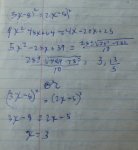allegansveritatem
Full Member
- Joined
- Jan 10, 2018
- Messages
- 962
I tried to solve the following problem in two ways:
Problem:
I tried both the square root property solution and the quadratic formula:
solutions:
I then checked the answers with a CAS calculator. The calculator came back with the same solutions as the quadratic formula did. Now my question is: Was the square root property solution partially right? And if so, why didn't I get two solutions as I did with the quadratic formula?
Problem:
I tried both the square root property solution and the quadratic formula:
solutions:

I then checked the answers with a CAS calculator. The calculator came back with the same solutions as the quadratic formula did. Now my question is: Was the square root property solution partially right? And if so, why didn't I get two solutions as I did with the quadratic formula?
